Buying a Sportboat: Focus on Performance
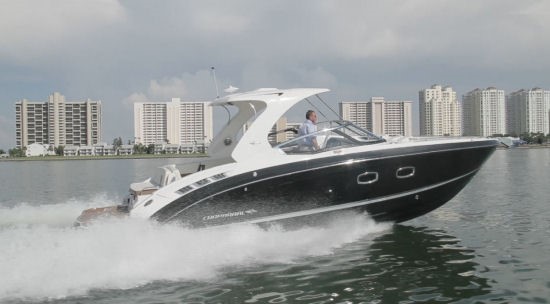
By comparing 10 important details, boat buyers can zero in on which boat really delivers best on the promise and is the best value.
With so many choices, figuring out which sportboat is best for you is not an easy task. With every builder saying that their boats are the highest quality, have the best features, and are the best value, what is a consumer to do? Our suggestion is to do what our test captains do: look at the details and compare them feature by feature. BoatTEST.com captains use a checklist of 10 points to inspect before writing their Captain's Reports on the boats they test.
10 Details To Compare Before You Buy:
1. Performance
2. Type of engine/Horsepower
3. Hull Configuration
4. Beam
5. Displacement
6. Helm Seat
7. Windshield Visibility
8. Swim Platform
9. Seating
10. Amenities
1. Performance
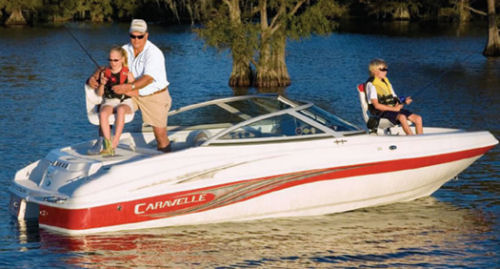
Here is a man who has at least two missions for his sportboat – to teach his kids how to fish, and we bet he plans to teach them how to ski as well.
A. Mission Determines Performance Required
It sounds obvious, but the first thing sportboat buyers must do is to decide exactly what the boat is to be used for. We call this the boat’s “mission.” Once you have defined the mission of the sportboat you want to buy, it is time to ascribe to that mission the required performance characteristics.
For example, a beginning water skier will need a boat with a quick holeshot to make it easier to get up. This requirement means that care must be given to both engine and prop selection.
The cool dude who wants to have the fastest boat on the lake better consider a large engine, the best prop geometry, and high-speed handling characteristics. Wake boarders need to consider the boat's handling and fuel economy at the best speed for riding the curl, and so forth.
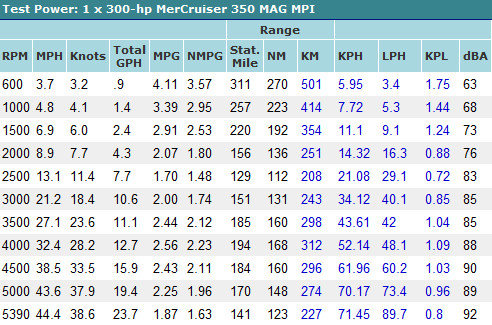
This is the moment of truth for all boats: the BoatTEST.com performance tables.
B. Speed and Fuel Consumption
When we speak of “performance” we are talking about these basic aspects of the boat:
1. WOT (wide open throttle) speed. We do not pay much attention to fuel consumption at WOT because the boat is driven at this speed only for short periods of time.
2. Fuel consumption at intended speed for the primary activity planned.
3. Lowest fuel consumption at a solid planing speed.
4. Best overall cruise speed in terms of miles per gallon burned.
5. Zero-to-plane time (hole shot).
6. Zero-to-30-mph time.
7. Sound level at the helm in terms of decibels (on the A scale). Remember that OSHA limits workplace noise exposure to 90 dB(A) to 8 hours. It permits exposure to higher numbers, but for a shorter period of time, for example 95 dB(A) for 4 hours, 100 dB(A) for 2 hours. The U.S. Department of Defense requires ear protection for military personnel exposed to noise over 85 dB(A).
8. Range in terms of miles and hours at the intended level of fuel consumption or at the desired speed.
9. Handling ability and the boat’s behavior at different speeds and with different loads.
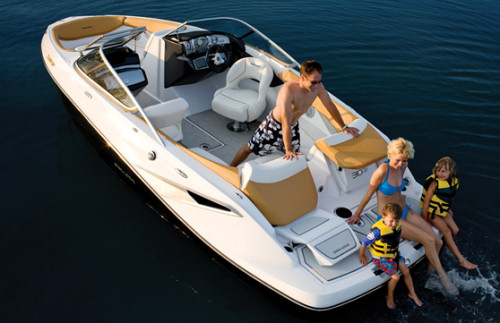
Most sportboats are designed for a small family or four or five average-weight people.
C. Weight Affects Performance
All sportboats are weight sensitive, but small ones are the most sensitive of all. For example, the addition of a 200-pound (90.7 kg) man to a sportboat as a passenger may represent 10% of the total weight of the boat. Add five people like that – 1,000 pounds (453.6 kg) – and you have just increased the weight of the boat by 50% and it will perform quite differently than it would with only two 150-pound (68 kg) people aboard.
BoatTEST.com Caveat: Virtually all boat tests conducted by BoatTEST.com are conducted with two people aboard and the total weight of the boat with fuel, water, people, and gear is given in the data sheet. In addition to that the weather conditions on the day of testing will affect the performance of the boat. Some of those factors in addition to weight are: altitude, freshwater or saltwater, depth of water, ambient temperature, humidity, wind speed, and wave height.
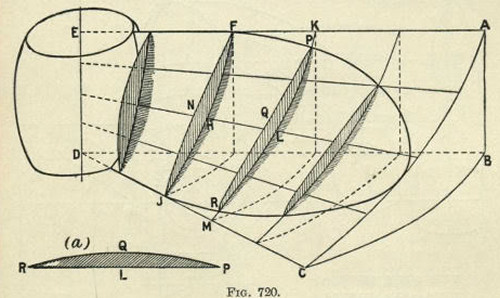
After the size of your engine and the weight of your boat, prop geometry is perhaps the next most critical detail for performance.
D. Propeller Geometry
One of the most critical details governing a boat’s performance is its prop. Certain prop geometry will improve hole shot, while another design will produce a higher WOT speed. Most sportboat builders put on as standard equipment a prop that they consider to be the best all-around prop for most of their customers. That means the boat you buy – and the test numbers you see published – may not be the best the boat can do for your particular mission.
However, by changing the pitch, cup, the number of blades, and other geometry, most boats’ performance can be improved for specific missions.
When comparing performance among boats, be sure to find out what prop each boat was tested with.
Reader Comments Should be sent to: [email protected]